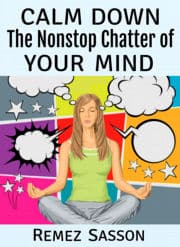
People have always searched for ways to unwind, relax, and escape the daily whirlwind of stress. One method that has been immensely popularized in the West in the past few decades is meditation.
While it’s true that meditation can bring about deep relaxation, it’s important to understand that this relaxation is actually a by-product rather than the primary goal of meditation. Meditation, at its core, aims to quiet the relentless chatter of the mind, bring true inner peace, and help you realize your true essence.
The Deeper Purpose of Meditation
The essence of meditation goes beyond simply calming the body. It seeks to silence the restless, ever-busy mind. We often find ourselves plagued by endless thoughts, worries, and plans that can lead to mental exhaustion.
Browse our online courses on meditation, positive thinking, overcoming procrastination, and freedom from distractions.
Meditation offers a gateway to step beyond this noise and experience the stillness that resides deep within us.
The experience of this inner stillness and silence is what brings about relaxation. A natural sense of calmness and tranquility emerges when the mind becomes silent. You are no longer a victim of racing thoughts or an endless mental dialogue. Instead, you become the observer, aware yet serene.
However, life has become hectic and stressful, and people are searching for ways to relax and reduce stress. Most people nowadays have no patience to delve into their inner selves. Concentration has deteriorated, and the attention span has decreased. People nowadays want fast results. Meditation, in its simplest forms, has emerged to answer these needs.
It is for these reasons that many think of meditation as just a technique for reducing stress and anxiety, oblivious to the other benefits of meditation.
We have talked about meditation, its benefits, and the various meditation techniques in other articles on this website, and therefore, here, we will focus only on meditation for relaxation.
How Meditation Brings Relaxation
While the primary aim of meditation is to gain control over the mind and access a state of inner peace, it inevitably creates profound relaxation as a secondary effect. Here’s how:
- Lowered Heart Rate and Blood Pressure: When your mind is calm, your body follows. Meditation activates the parasympathetic nervous system, which promotes a state of rest and restoration. This effect reduces your heart rate and lowers blood pressure, aiding in physical relaxation.
- Decreased Stress Hormones: Meditation can reduce levels of stress hormones like cortisol. As your stress response decreases, your body releases less adrenaline, which naturally fosters relaxation.
- Enhanced Awareness and Presence: By focusing on your breath or an object of concentration, your mind is redirected away from worries. This focused attention quiets the chaos and creates a serene state where stress fades away.
Meditation for Relaxation: Effective Meditation Techniques for Relaxation
To achieve deep relaxation through meditation, you must aim to quiet the mind so you can achieve inner peace.
Remember, when the mind is quiet the body becomes quiet, too.
Also, when the body gets quiet, the mind becomes quieter. When both are quiet there is less stress, strain and restlessness.
Here are a few methods that can guide you:
1. Breath Awareness Meditation
Purpose: To calm the mind by focusing entirely on your breath.
How to Practice Breath Awareness Meditation: Sit comfortably with your back straight. Close your eyes and take a few deep breaths. Then, allow your breathing to find a natural rhythm. Bring your attention to the sensation of your breath entering and leaving your nostrils or the rise and fall of your chest.
Each time your mind wanders, gently bring it back to your breath. Over time, your mind will become quieter, and your body will naturally relax.
2. Body Scan Meditation
Purpose: To release physical tension by becoming aware of your body.
How to Practice Body Scan Meditation: Lie down or sit comfortably. Close your eyes and take a few deep breaths.
Then, starting from the top of your head, slowly scan your body, becoming aware of any sensations, tension, or discomfort. Move your awareness gradually down to your toes, consciously releasing any tension.
As your body relaxes, your mind will become calmer, and inner silence can be more easily achieved.
3. Object Concentration
Purpose: To focus the mind and draw it away from distractions.
How to Practice Object Concentration: Choose a simple object, like a candle flame or a flower. Sit comfortably and fix your gaze on the object. Observe its shape, colors, and details. Keep your mind on the object, and if thoughts arise, gently bring your attention back. Over time, the mind will quiet, and the body will respond with relaxation.
4. Guided Meditation
Purpose: Guided meditation for relaxation is a powerful technique to unwind your mind and body, ease tension, and release stress. It involves listening to a soothing voice or audio guide that directs your focus toward calming visualizations, slow breathing, or body awareness.
How to Practice: Begin by finding a quiet space where you won’t be disturbed. Sit or lie down in a comfortable position, and close your eyes. Play a guided meditation audio or app, and let the guide take you through gentle breathing exercises and relaxing imagery.
Whether it’s imagining a serene beach or feeling tension melt away from your body, this practice helps you connect with peace. With regular sessions, guided meditation for relaxation can become a vital tool for managing stress and enhancing your overall well-being.
Tips for a Deep and Meaningful Practice
- Consistency: Meditation is most effective when practiced regularly. Start with five to ten minutes a day and gradually increase as you become more comfortable.
- Setting the Right Environment: Choose a quiet space where you won’t be disturbed. A tranquil environment can help your mind settle faster.
- Gentleness with Your Mind: Your mind will wander. Instead of getting frustrated, guide it back with patience and kindness. Remember, the aim is not to force silence but to allow it to emerge.
Meditation for Sleep and Relaxation
When it comes to unwinding at the end of the day, meditation can be a powerful tool for promoting restful sleep and deep relaxation.
Sleep difficulties are often caused by an overactive mind that won’t let go of the day’s worries and plans. By practicing meditation for sleep and relaxation before bed, you can quiet this mental chatter, release tension from the body, and create a peaceful state conducive to restorative sleep.
One effective method is Progressive Muscle Relaxation (PMR) combined with meditation. This technique involves tensing and then gradually releasing different muscle groups in the body while maintaining an awareness of the sensations.
As you relax each muscle, imagine the tension melting away and your body sinking deeper into comfort.
Another method is to visualize yourself sitting or walking in a quiet place, such as on a river bank, the beach, or a park. Make the scene real and enjoy it. Don’t use effort to visualize. It should be like a pleasant daydream.
As your attention shifts away from stressors and towards a calming scene, your mind and body are lulled into a state of deep relaxation, setting the stage for a restful night’s sleep.
Practice these methods for meditation for sleep when you are already in bed.
Meditation for sleep isn’t just about falling asleep faster; it’s about creating an environment of inner peace where your mind can rest deeply. As you regularly practice sleep meditation, you’ll likely find that you wake up more refreshed and rejuvenated, carrying the tranquility of a calm mind into the day ahead.
Final Words about Meditation for Relaxtion and Better Sleep
Nowadays, we can find pleanty of information, guidance, and methods for practicing meditation for relaxtion and improving sleep.
While relaxation is a welcome outcome of meditation, the journey goes deeper. By focusing on quieting the chatter of the mind, you unlock a level of inner peace that brings with it immense calmness.
True relaxation comes when your mind no longer fights the present moment and is instead enveloped by silence and stillness. So, the next time you meditate, remember to aim for inner peace, and relaxation will naturally follow.
Interested in more practical information, guidance and advice about inner peace and a quiet mind? Read and practice the guidance in our book Calm Down the Nonstop Chatter of Your Mind.
Image source – DepositPhotos
Browse our online courses on meditation, positive thinking, overcoming procrastination, motivation, and freedom from distractions.



